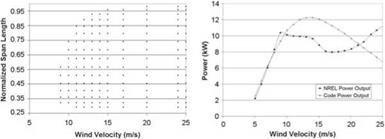Validation
The helicoidal vortex model has been applied to a large number of cases, steady and unsteady, from the two-bladed rotor NREL S Data Sequence, in order to explore the domain of validity and assess the accuracy of this approach [16], see Table 10.1. In the experiments, the rotation speed of the turbine was held constant at 72rpm, thus velocity was the main control parameter to vary the TSR. As velocity increases and TSR decreases, stall affects a larger and larger part of the blades. In steady flow conditions (в = 0), incipient separation occurs around 8m/s and then spreads to the whole blade above 15m/s. This is shown in Fig. 10.19 where the left graph indicates with dots the points along the blade where stall occurs. The right plot shows the steady power output comparison with the experimental data.
As can be seen, the agreement with the power output is excellent until V = 8m/s, that is until there is separated flow on the blades.
|
|
|
Fig. 10.19 Spanwise stall and steady power output versus wind speed |
The effect of yaw on power is analyzed. The flow at yaw is periodic and the average power is calculated and compared with the average power given in the NREL data base. The results are shown in Fig. 10.20. Good results are obtained with the vortex model for yaw angles of up to в = 20°. This is consistent with the approximate treatment of the vortex sheets.
|
Fig. 10.20 Average power output versus wind speed at в = 5, 10, 20 and 30° |

















